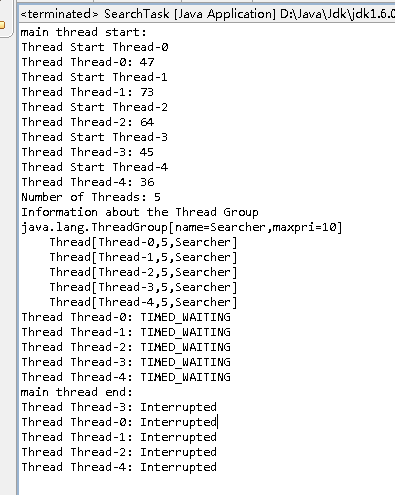林炳文Evankaka原创作品。转载请注明出处http://blog.csdn.net/evankaka
摘要:线程组ThreadGroup表示一组线程的集合,一旦一个线程归属到一个线程组之中后,就不能再更换其所在的线程组。那么为什么要使用线程组呢?个人认为有以下的好处:方便统一管理,线程组可以进行复制,快速定位到一个线程,统一进行异常设置等。ThreadGroup它其实并不属于Java并发包中的内容,它是java.lang中的内容。但是掌握对其的于理解,在实际应用中有很大的帮助。
一、基本方法
1、获取当前线程组名
Thread.currentThread().getThreadGroup().getName()2、将线程放入到一个线程组中去
ThreadGroup threadGroup1 = new ThreadGroup("group1");
ThreadGroup threadGroup2 = new ThreadGroup("group2");
Thread thread1 =new Thread(threadGroup1, "group1's member");
Thread thread2 =new Thread(threadGroup2, "group2's member"); public Thread(ThreadGroup group, Runnable target) {
init(group, target, "Thread-" + nextThreadNum(), 0);
}
public Thread(ThreadGroup group, String name) {
init(group, null, name, 0);
}
public Thread(ThreadGroup group, Runnable target, String name) {
init(group, target, name, 0);
}
public Thread(ThreadGroup group, Runnable target, String name,
long stackSize) {
init(group, target, name, stackSize);
} private void init(ThreadGroup g, Runnable target, String name,
long stackSize) {
Thread parent = currentThread();
SecurityManager security = System.getSecurityManager();
if (g == null) {
//安全检查
if (security != null) {
g = security.getThreadGroup();
}
//设置线程组
if (g == null) {
g = parent.getThreadGroup();
}
}
//检查可达性
g.checkAccess();
//是否有权限访问
if (security != null) {
if (isCCLOverridden(getClass())) {
security.checkPermission(SUBCLASS_IMPLEMENTATION_PERMISSION);
}
}
//往线程组添加线程但未启动
g.addUnstarted();
this.group = g;
this.daemon = parent.isDaemon();//是否守护线程
this.priority = parent.getPriority();//优先级
this.name = name.toCharArray();
if (security == null || isCCLOverridden(parent.getClass()))
this.contextClassLoader = parent.getContextClassLoader();
else
this.contextClassLoader = parent.contextClassLoader;
this.inheritedAccessControlContext = AccessController.getContext();
this.target = target;
setPriority(priority);
if (parent.inheritableThreadLocals != null)
this.inheritableThreadLocals =
ThreadLocal.createInheritedMap(parent.inheritableThreadLocals);
this.stackSize = stackSize;
tid = nextThreadID();
this.me = this;
}3、复制线程组:
//这样可以复制group里面的thread信息
Thread[] threads = new Thread[threadGroup.activeCount()];
threadGroup.enumerate(threads);4、未捕获异常处理
ThreadGroup中有一个uncaughtException()方法。当线程组中某个线程发生Unchecked exception异常时,由执行环境调用此方法进行相关处理,如果有必要,可以重新定义此方法
二、应用实例
1、实例应用package com.func.axc.threadgroup;
import java.util.Date;
import java.util.Random;
import java.util.concurrent.TimeUnit;
class Result {
private String name;
public String getName() {
return name;
}
public void setName(String name) {
this.name = name;
}
}
public class SearchTask implements Runnable {
public SearchTask(Result result) {
this.result = result;
}
private Result result;
@Override
public void run() {
String name = Thread.currentThread().getName();
System.out.println("Thread Start " + name);
try {
doTask();
result.setName(name);
} catch (InterruptedException e) {
System.out.printf("Thread %s: Interrupted\n", name);
return;
}
System.out.println("Thread end " + name);
}
private void doTask() throws InterruptedException {
Random random = new Random((new Date()).getTime());
int value = (int) (random.nextDouble() * 100);
System.out.printf("Thread %s: %d\n", Thread.currentThread().getName(),
value);
TimeUnit.SECONDS.sleep(value);
}
public static void main(String[] args) {
System.out.println("main thread start:");
//创建5个线程,并入group里面进行管理
ThreadGroup threadGroup = new ThreadGroup("Searcher");
Result result = new Result();
SearchTask searchTask = new SearchTask(result);
for (int i = 0; i < 5; i++) {
Thread thred = new Thread(threadGroup, searchTask);
thred.start();
try {
TimeUnit.SECONDS.sleep(1);
} catch (InterruptedException e) {
e.printStackTrace();
}
}
//通过这种方法可以看group里面的所有信息
System.out.printf("Number of Threads: %d\n", threadGroup.activeCount());
System.out.printf("Information about the Thread Group\n");
threadGroup.list();
//这样可以复制group里面的thread信息
Thread[] threads = new Thread[threadGroup.activeCount()];
threadGroup.enumerate(threads);
for (int i = 0; i < threadGroup.activeCount(); i++) {
System.out.printf("Thread %s: %s\n", threads[i].getName(),
threads[i].getState());
}
waitFinish(threadGroup);
//将group里面的所有线程都给interpet
threadGroup.interrupt();
System.out.println("main thread end:");
}
private static void waitFinish(ThreadGroup threadGroup) {
while (threadGroup.activeCount() > 0) {
try {
TimeUnit.SECONDS.sleep(1);
} catch (InterruptedException e) {
e.printStackTrace();
}
}
}
}

2、统一异常处理实例
package com.func.axc.threadgroup;
/**
* 功能概要:
*
* @author linbingwen
* @since 2016年6月11日
*/
public class ThreadGroupDemo {
public static void main(String[] args) {
ThreadGroup threadGroup1 =
// 这是匿名类写法
new ThreadGroup("group1") {
// 继承ThreadGroup并重新定义以下方法
// 在线程成员抛出unchecked exception
// 会执行此方法
public void uncaughtException(Thread t, Throwable e) {
System.out.println(t.getName() + ": " + e.getMessage());
}
};
// 这是匿名类写法
Thread thread1 =
// 这个线程是threadGroup1的一员
new Thread(threadGroup1, new Runnable() {
public void run() {
// 抛出unchecked异常
throw new RuntimeException("测试异常");
}
});
thread1.start();
}
}
三、源码解读
首先看其包含的变量
public class ThreadGroup implements Thread.UncaughtExceptionHandler {
private final ThreadGroup parent;//父亲ThreadGroup
String name;//ThreadGroupr 的名称
int maxPriority;//线程最大优先级
boolean destroyed;//是否被销毁
boolean daemon;//是否守护线程
boolean vmAllowSuspension;//是否可以中断
int nUnstartedThreads = 0;//还未启动的线程
int nthreads;//ThreadGroup中线程数目
Thread threads[];//ThreadGroup中的线程
int ngroups;//线程组数目
ThreadGroup groups[];//线程组数组从源码中可以看出,其包含的变量并不是很多。这里需要注意
(1)线程组也可以包含其他线程组。如上面的groups[].
(2)线程组构成一棵树,在树中,除了初始线程组外,每个线程组都有一个父线程组
构造函数:
//私有构造函数
private ThreadGroup() {
this.name = "system";
this.maxPriority = Thread.MAX_PRIORITY;
this.parent = null;
}
//默认是以当前ThreadGroup传入作为parent ThreadGroup,新线程组的父线程组是目前正在运行线程的线程组。
public ThreadGroup(String name) {
this(Thread.currentThread().getThreadGroup(), name);
}
//构造函数
public ThreadGroup(ThreadGroup parent, String name) {
this(checkParentAccess(parent), parent, name);
}
//私有构造函数
private ThreadGroup(Void unused, ThreadGroup parent, String name) {
this.name = name;
this.maxPriority = parent.maxPriority;
this.daemon = parent.daemon;
this.vmAllowSuspension = parent.vmAllowSuspension;
this.parent = parent;
parent.add(this);
} //检查parent ThreadGroup
private static Void checkParentAccess(ThreadGroup parent) {
parent.checkAccess();
return null;
} public void uncaughtException(Thread t, Throwable e) {
if (parent != null) {
parent.uncaughtException(t, e);//父线程组不为空,设置到父线程组
} else {
Thread.UncaughtExceptionHandler ueh =
Thread.getDefaultUncaughtExceptionHandler();
if (ueh != null) {
ueh.uncaughtException(t, e);
} else if (!(e instanceof ThreadDeath)) {
System.err.print("Exception in thread \""
+ t.getName() + "\" ");
e.printStackTrace(System.err);
}
}
}如果父线程组不存在, 但指定了默认处理器 (下节中的As the default handler for the application), 则调用默认的处理器
如果默认处理器没有设置, 则写错误日志.但如果 exception是ThreadDeath实例的话, 忽略
线程组复制:
//此线程组及其子组中的所有活动线程复制到指定数组中。
public int enumerate(ThreadGroup list[]) {
checkAccess();
return enumerate(list, 0, true);
}
//此线程组及其子组中的所有活动线程复制到指定数组中。
public int enumerate(ThreadGroup list[], boolean recurse) {
checkAccess();
return enumerate(list, 0, recurse);
}
//此线程组中的所有活动线程复制到指定数组中。如果 recurse 标志为 true,则还包括对此线程的子组中的所有活动线程的引用。如果数组太小而无法保持所有线程,则 //忽略额外的线程。
private int enumerate(ThreadGroup list[], int n, boolean recurse) {
int ngroupsSnapshot = 0;
ThreadGroup[] groupsSnapshot = null;
synchronized (this) {
if (destroyed) {
return 0;
}
int ng = ngroups;
if (ng > list.length - n) {//防止list放不下线程数目
ng = list.length - n;
}
if (ng > 0) {
System.arraycopy(groups, 0, list, n, ng);//复制线程组
n += ng;
}
if (recurse) { //取得其子组
ngroupsSnapshot = ngroups;
if (groups != null) {
groupsSnapshot = Arrays.copyOf(groups, ngroupsSnapshot);
} else {
groupsSnapshot = null;
}
}
}
if (recurse) {//复制子组
for (int i = 0 ; i < ngroupsSnapshot ; i++) {
n = groupsSnapshot[i].enumerate(list, n, true);
}
}
return n;
}上面就是一些主要的方法,其它的就不再细讲了。下一讲我们再来看看ThreadFactory、ThreadLocal这些经常看到的类。
参考文章:
http://blog.csdn.net/edward_qing_lee/article/details/8767612
http://www.tuicool.com/articles/3aUjea
http://www.apihome.cn/api/java/ThreadGroup.html










 本文详细介绍了Java中的线程组ThreadGroup的概念、用途及其实现方式,包括如何创建线程组、线程组的基本方法、复制线程组以及统一异常处理等内容。
本文详细介绍了Java中的线程组ThreadGroup的概念、用途及其实现方式,包括如何创建线程组、线程组的基本方法、复制线程组以及统一异常处理等内容。

















 被折叠的 条评论
为什么被折叠?
被折叠的 条评论
为什么被折叠?








